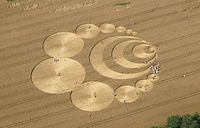
Photo from wikipedia
Abstract Relative to fallow-cash crop rotations, the addition of a cover crop can contribute to greater plant diversity and has the potential to conserve predatory arthropods. The transition of arthropods… Click to show full abstract
Abstract Relative to fallow-cash crop rotations, the addition of a cover crop can contribute to greater plant diversity and has the potential to conserve predatory arthropods. The transition of arthropods from a cover crop to a subsequent cash crop depends on several factors, such as cover crop biomass production and weather conditions. Information about the effect of cover crop planting and termination dates on arthropods in a subsequent corn system is limited. A two-year field study was conducted in Nebraska in 2018/2019 and 2019/2020 to evaluate the impact of cover crop planting and termination dates as a source for arthropods in the subsequent corn. A total of 38,074 and 50,626 arthropods were collected in the first and second year, respectively. In both years, adding a grass cover crop increased predatory arthropods but reduced yield in follow corn crop. Of the arthropods collected, Carabidae and Araneae had greater activity with cover crop biomass increments, whereas Collembola and Acari activity only increased in treatments with little or no cover crop biomass. Insect pest pressure was not significant in any treatment for either year. A cover crop planted in mid- or late-September and terminated at corn planting was identified as the best management strategy to maximize cover crop biomass, increase predator activity, and modify predator-prey dynamics. The results of this study provide growers with a cover crop management strategy to maximize cover crop biomass, beneficial arthropod activity, and potentially minimize insect pest problems; however, corn Zea Mays (L.) grain yield was reduced as cover crop biomass increased.
Journal Title: Journal of Economic Entomology
Year Published: 2022
Link to full text (if available)
Share on Social Media: Sign Up to like & get
recommendations!